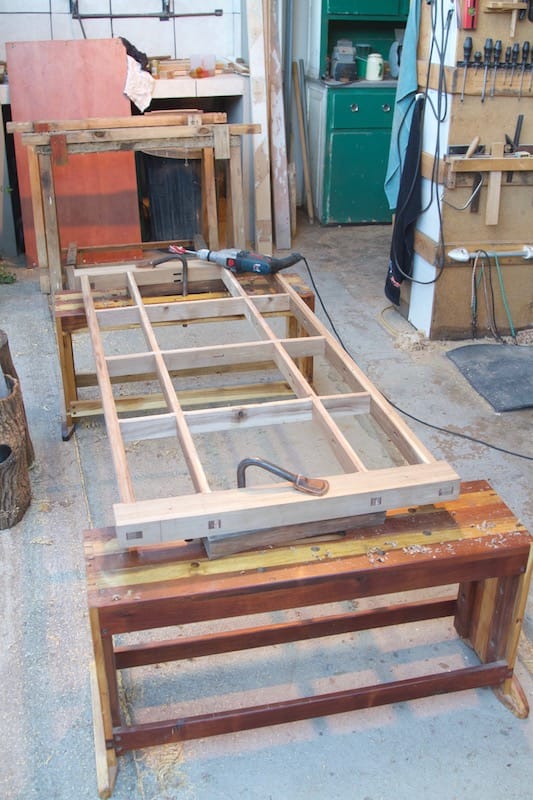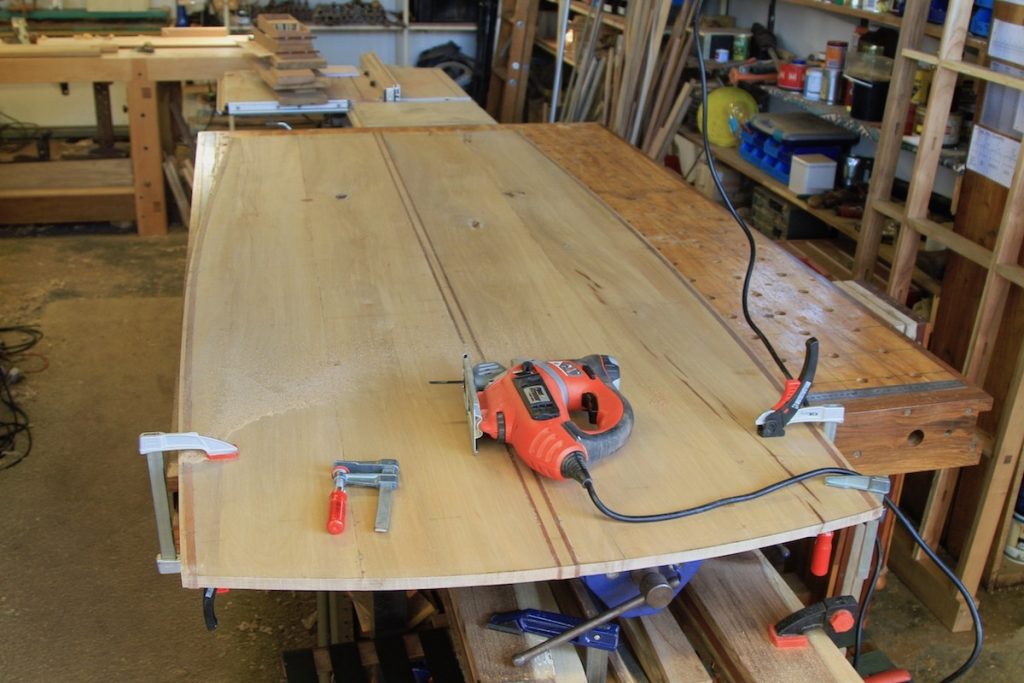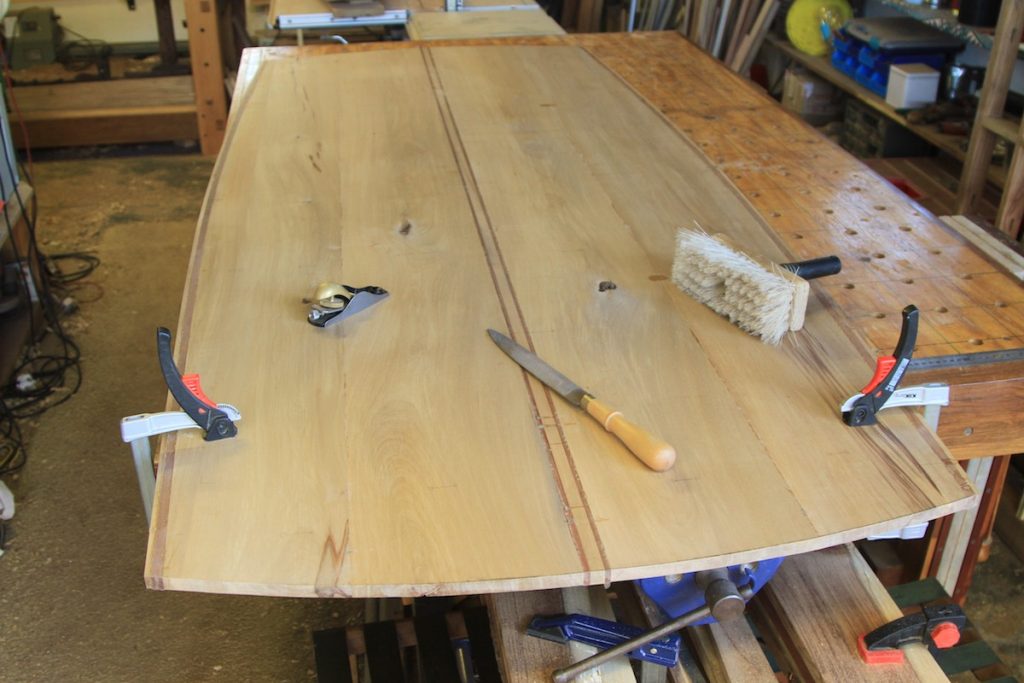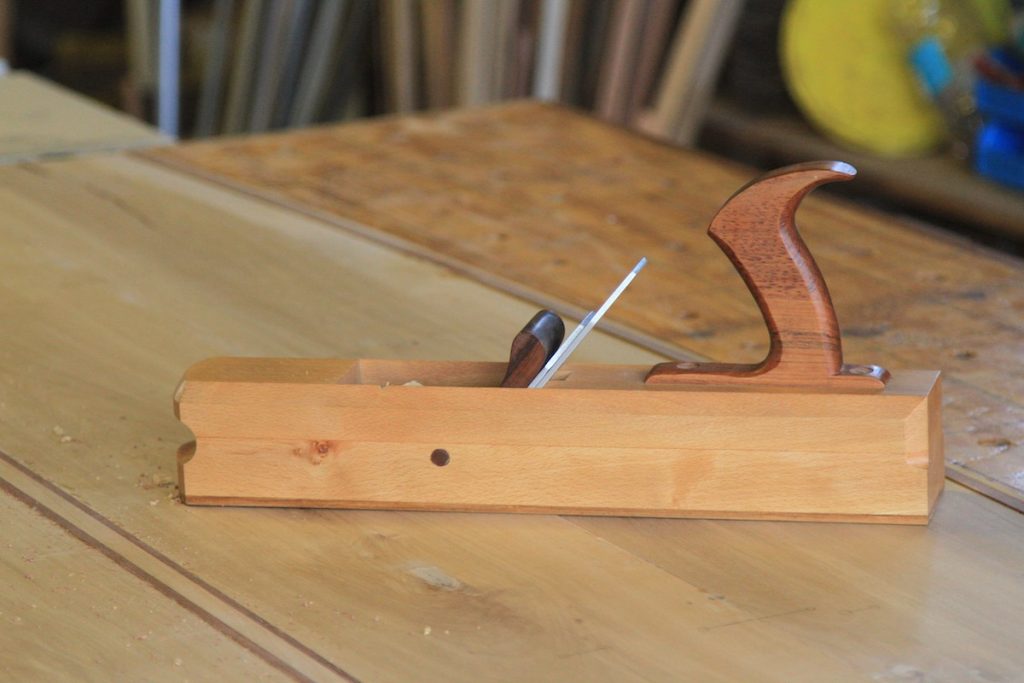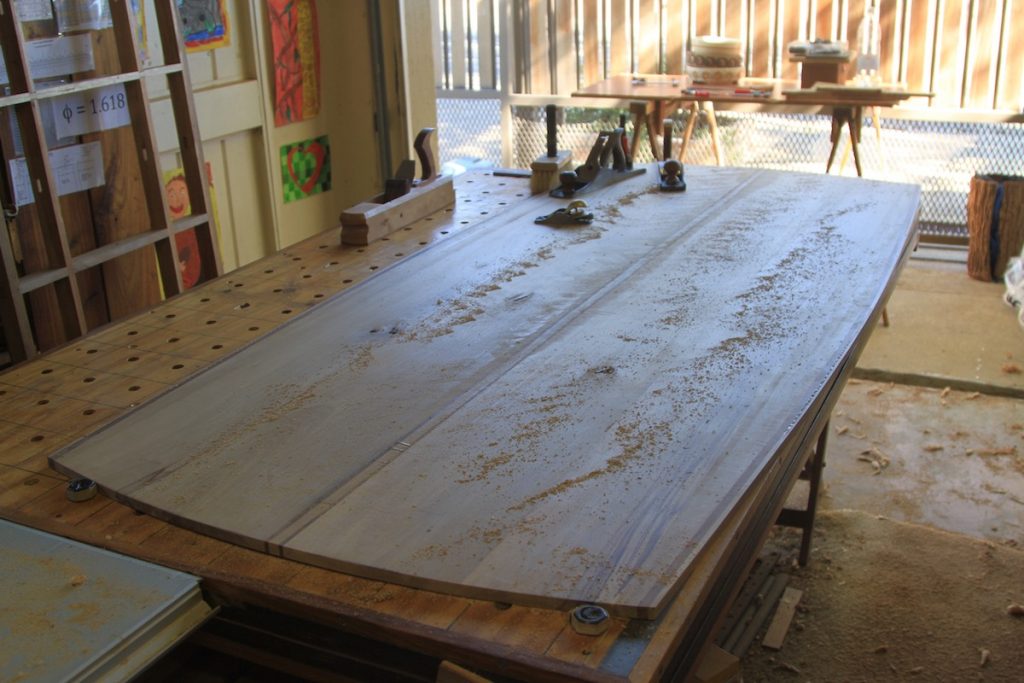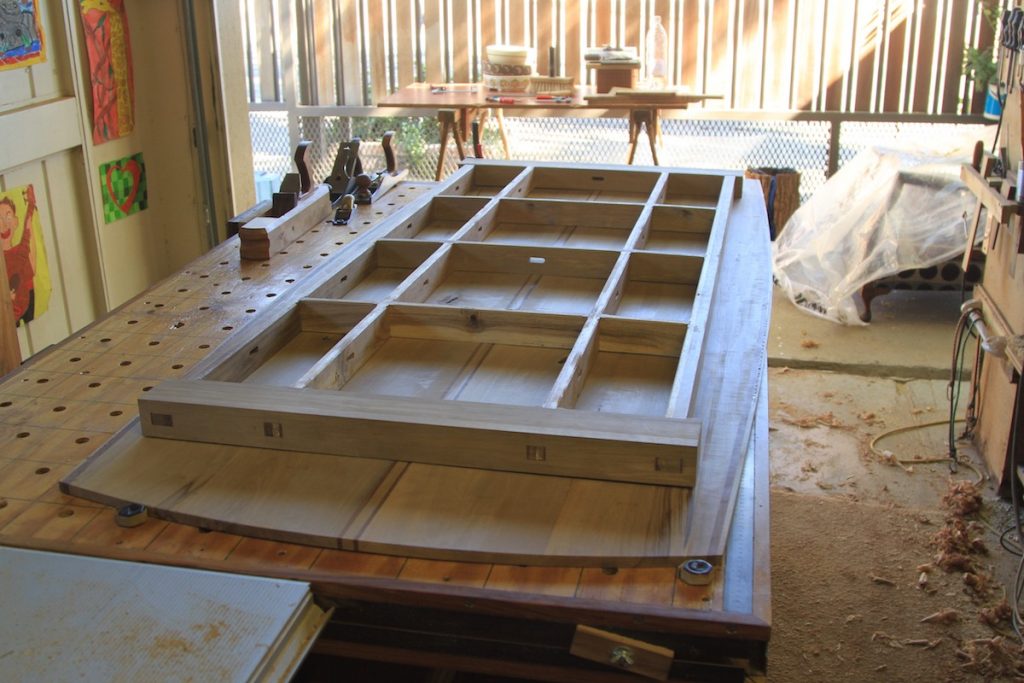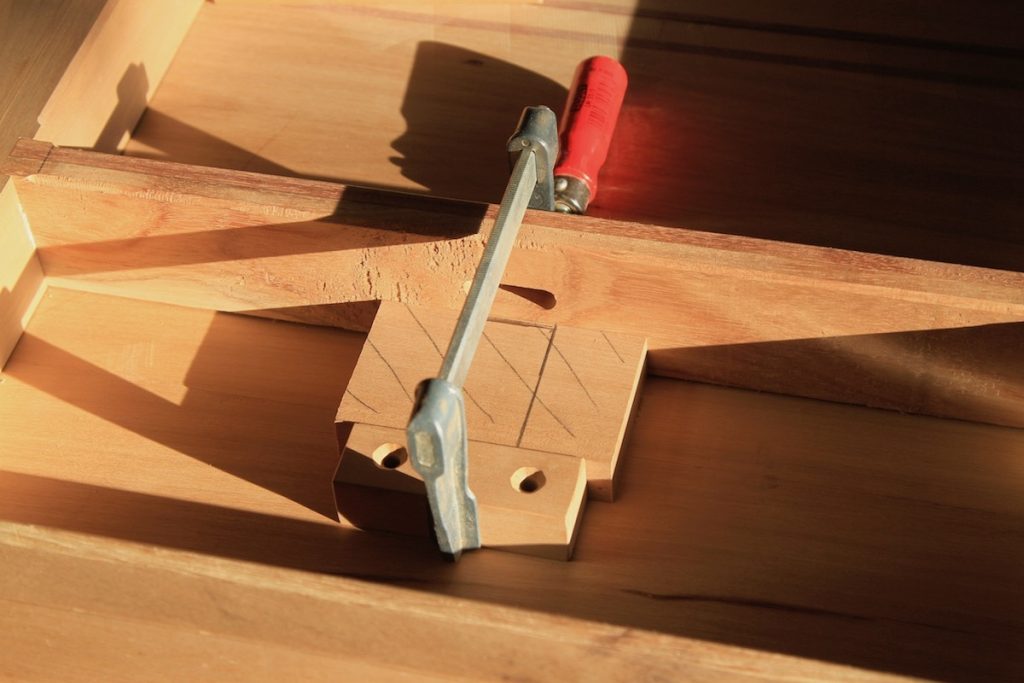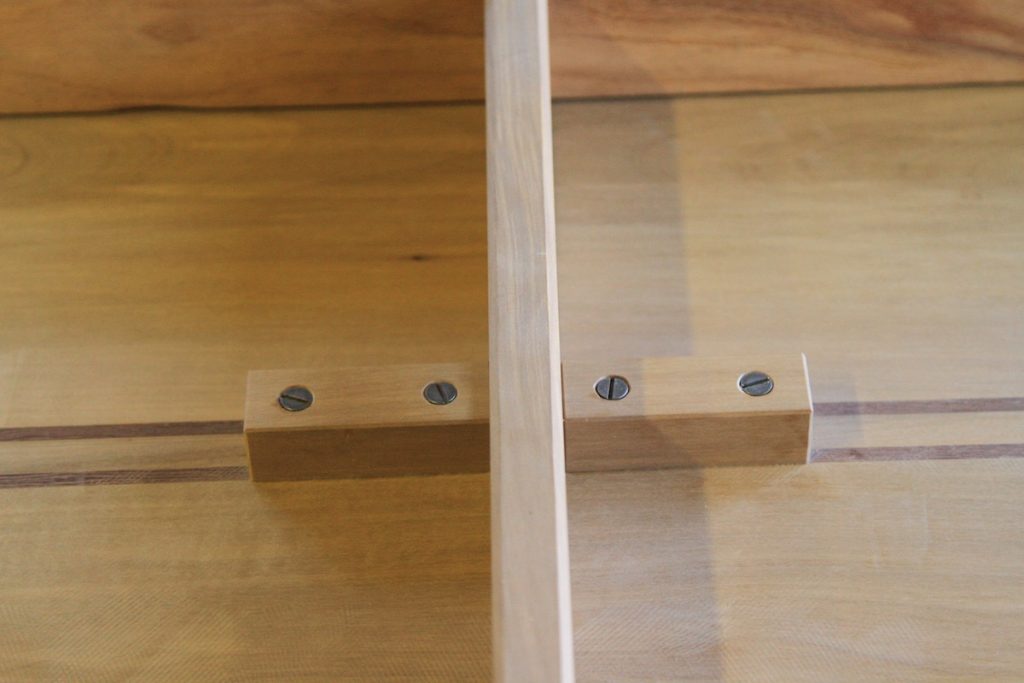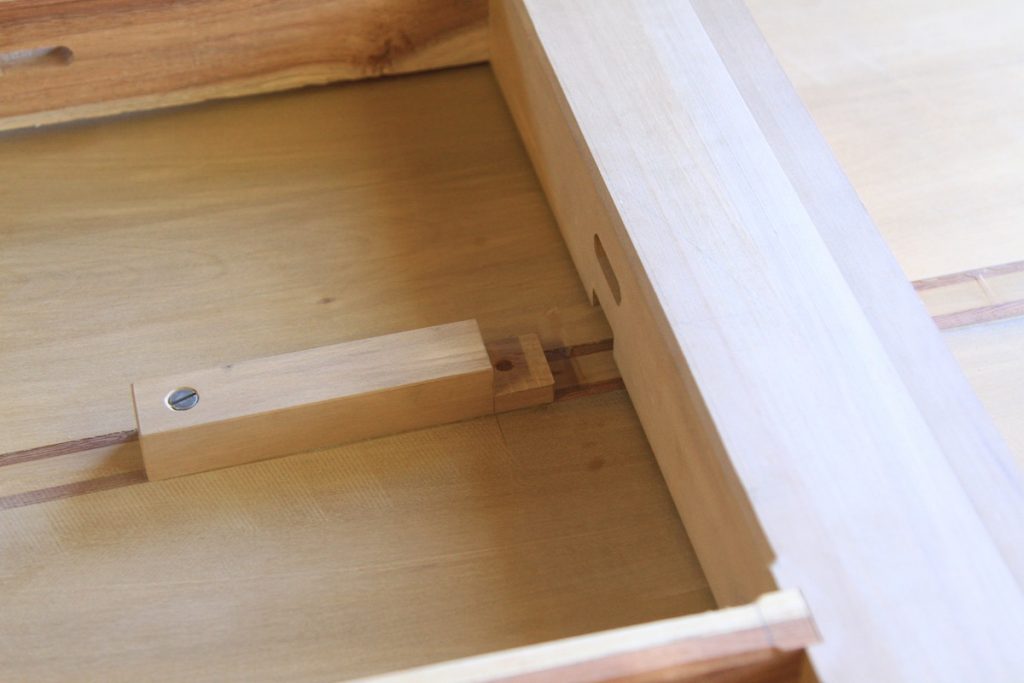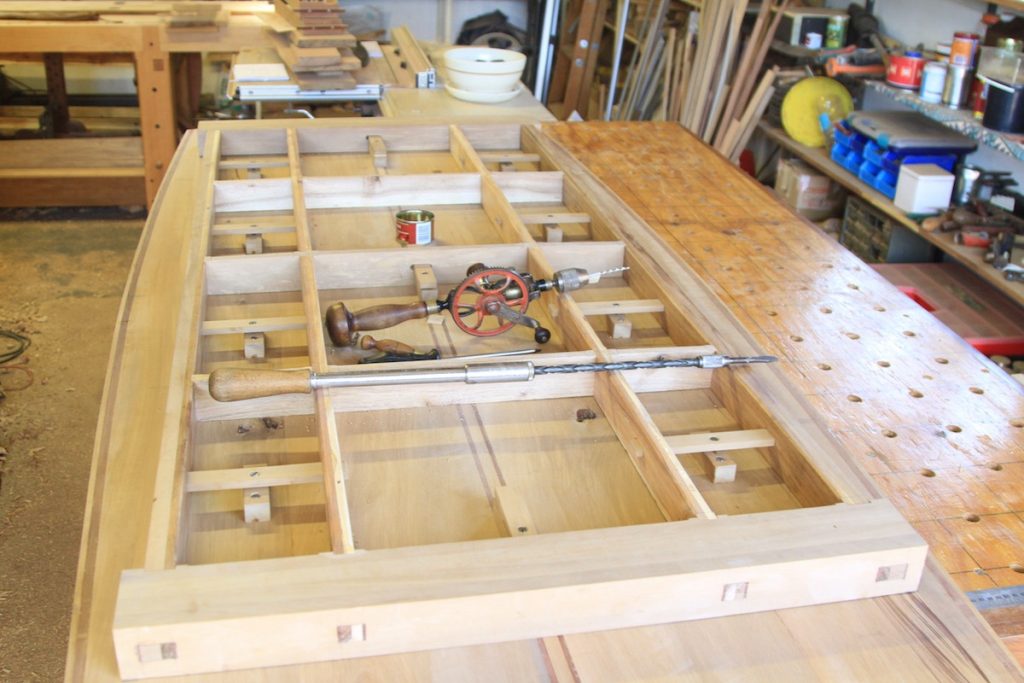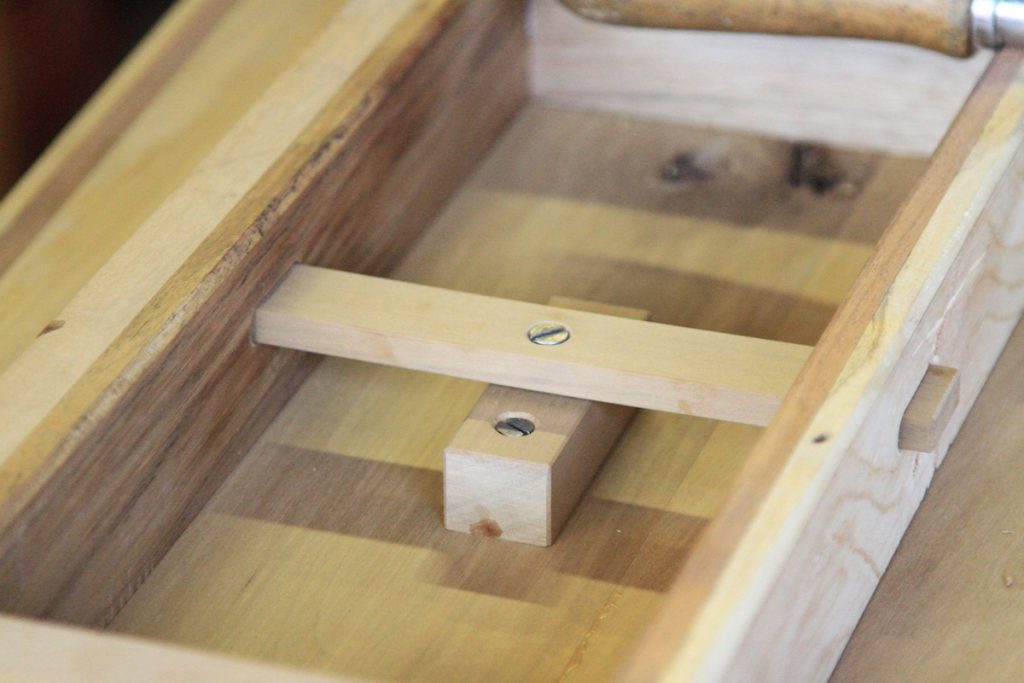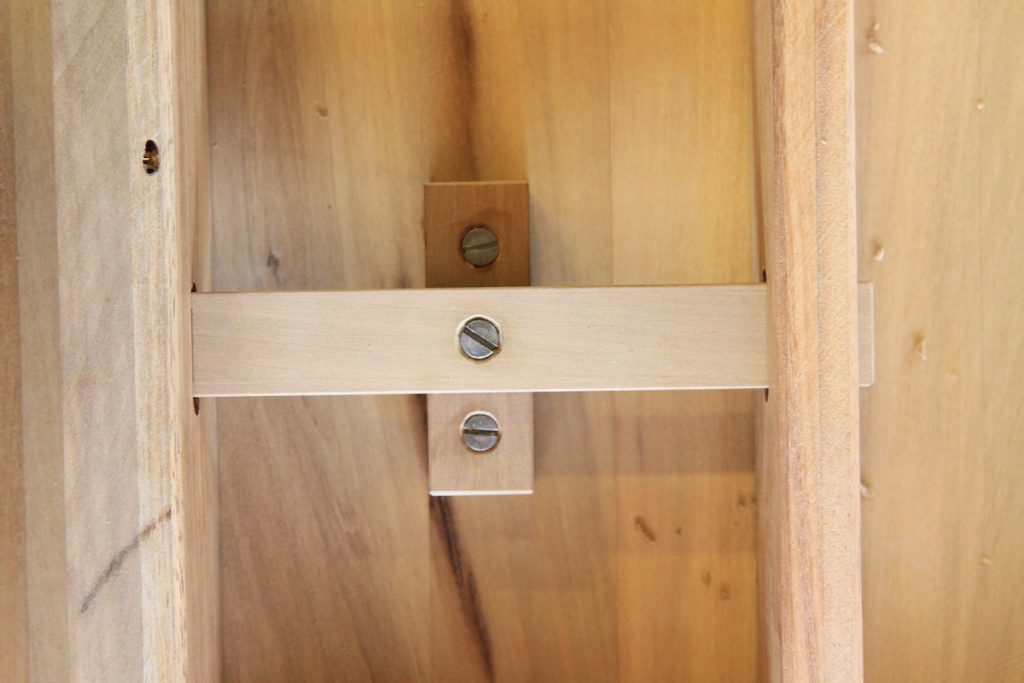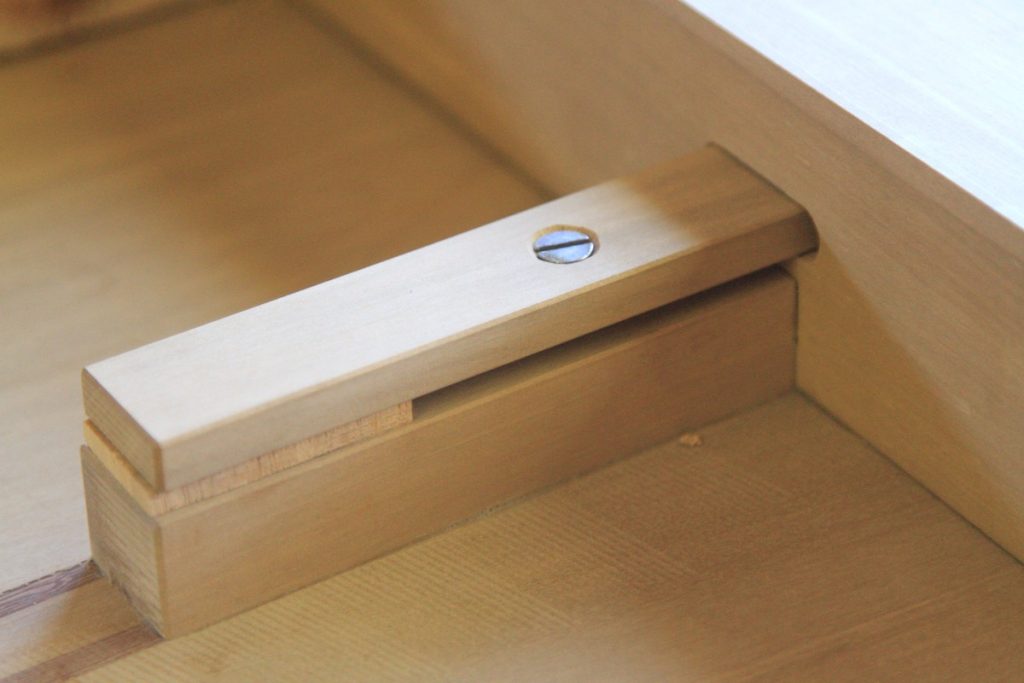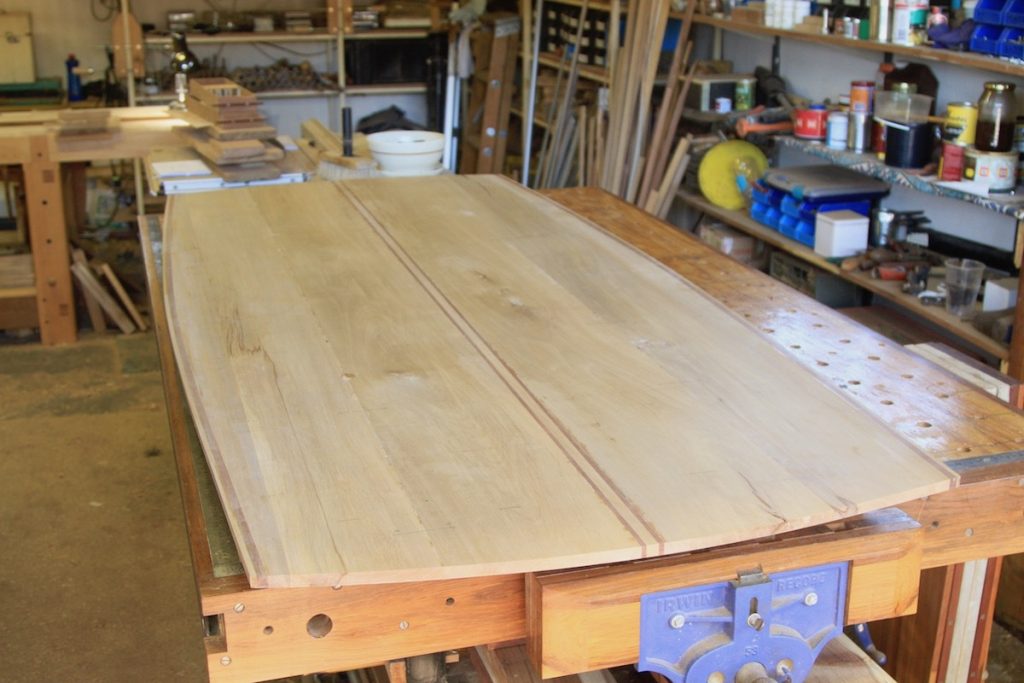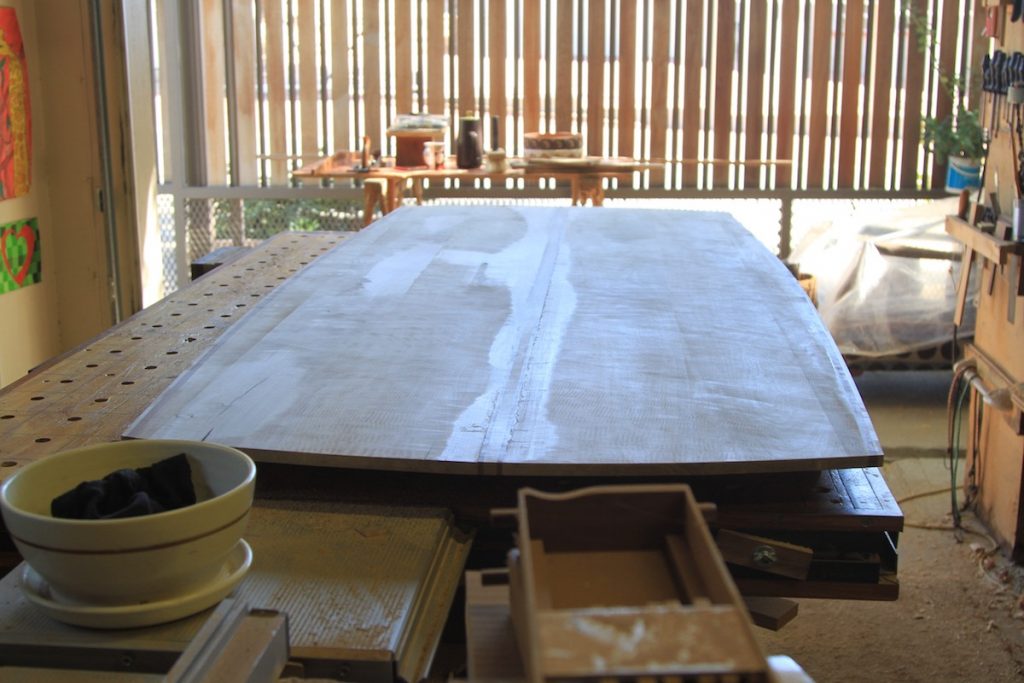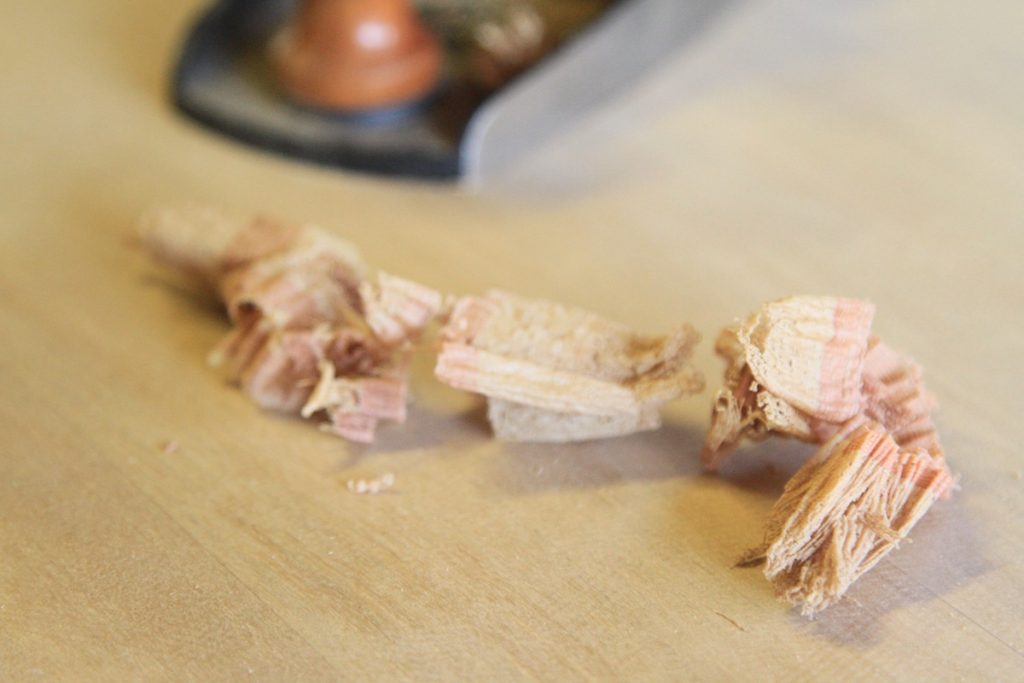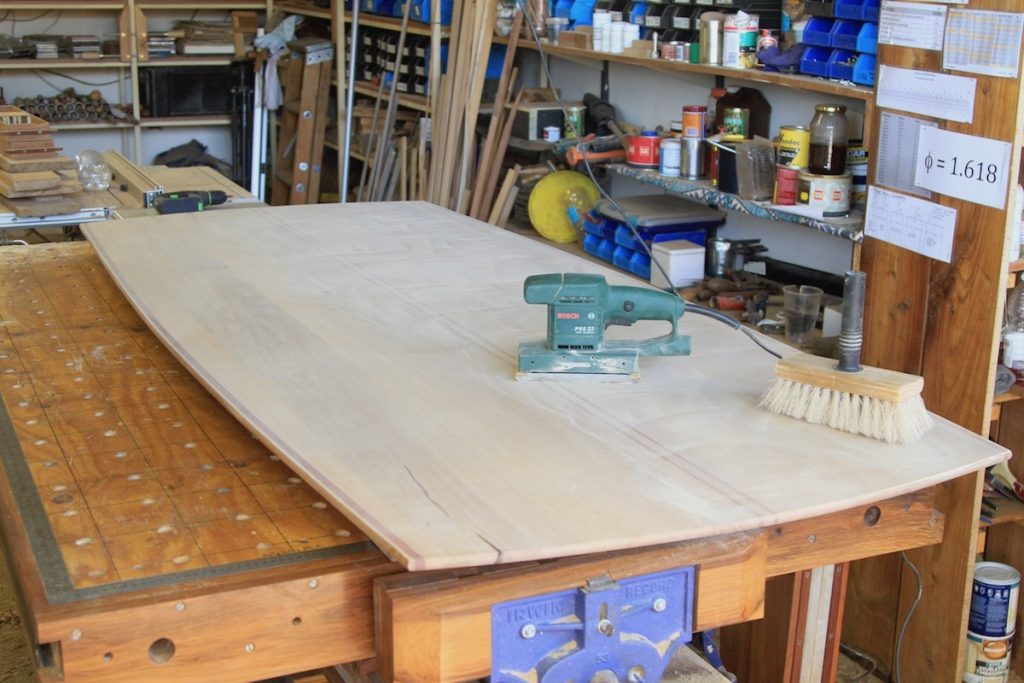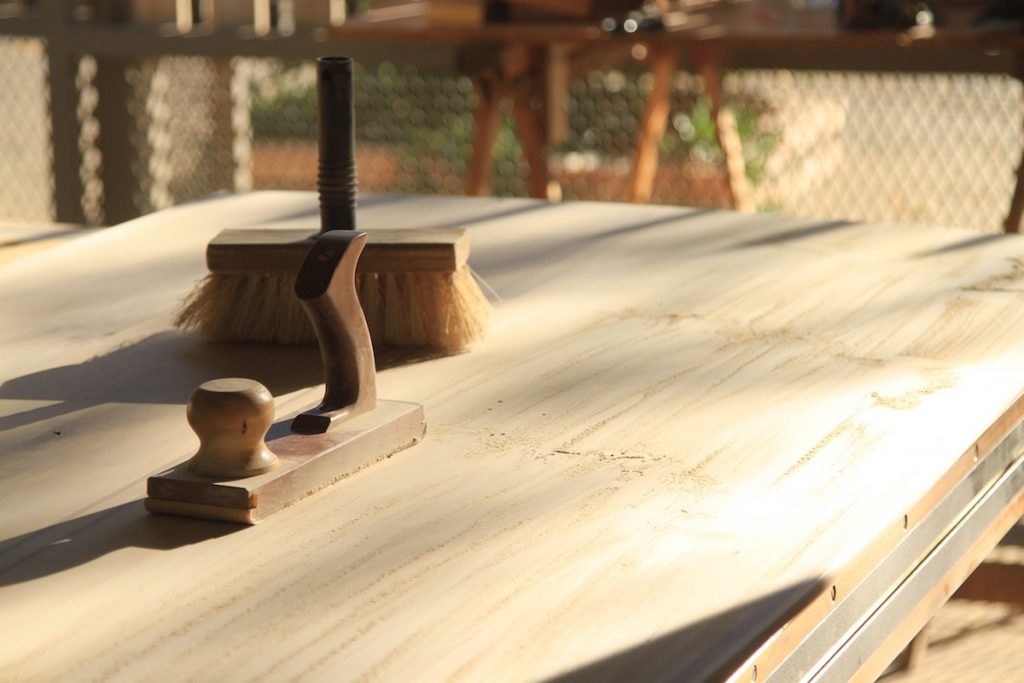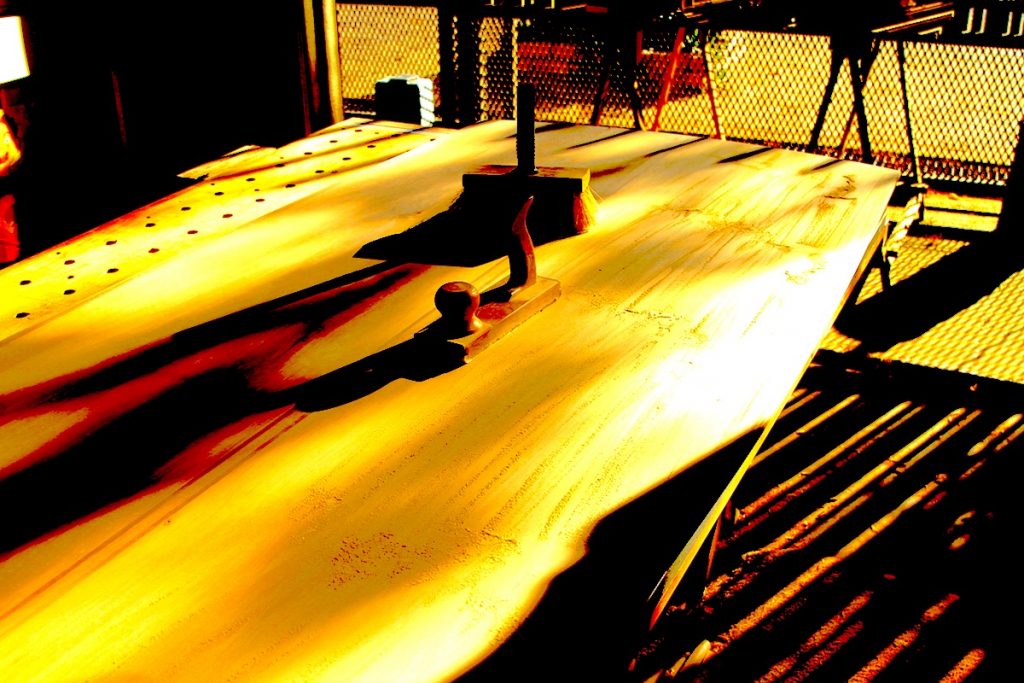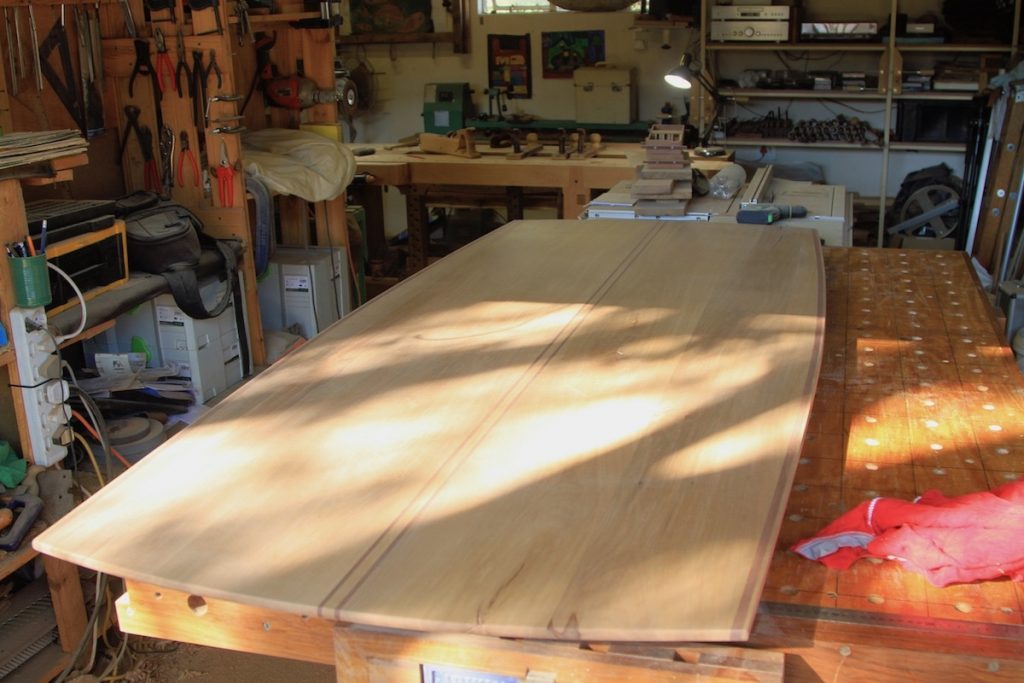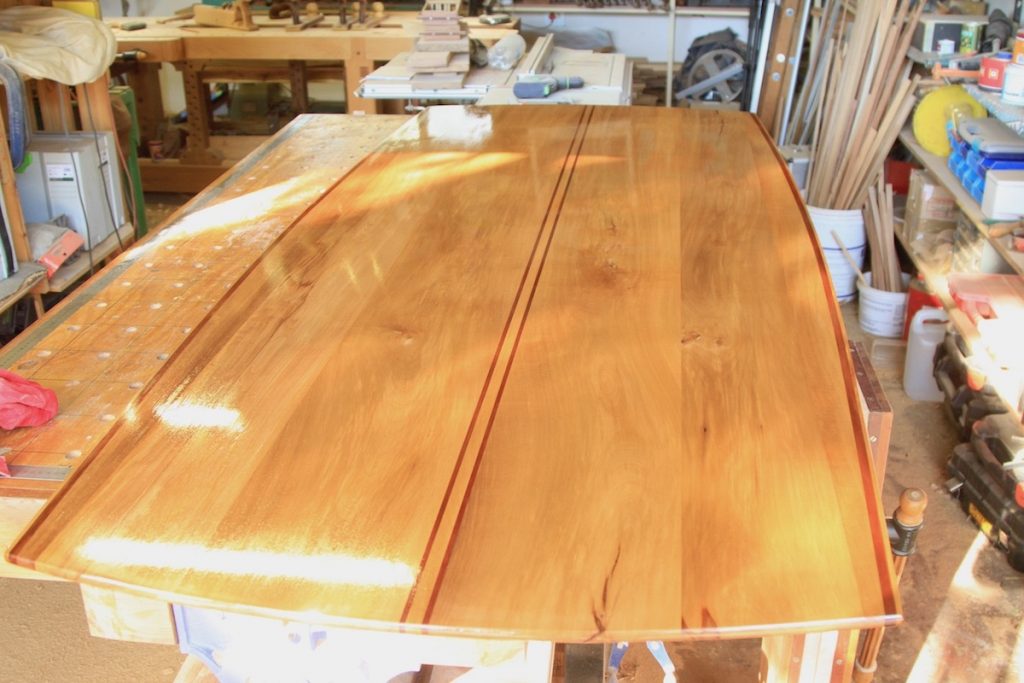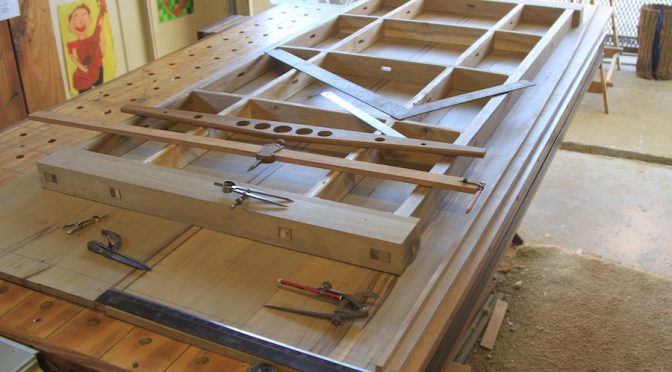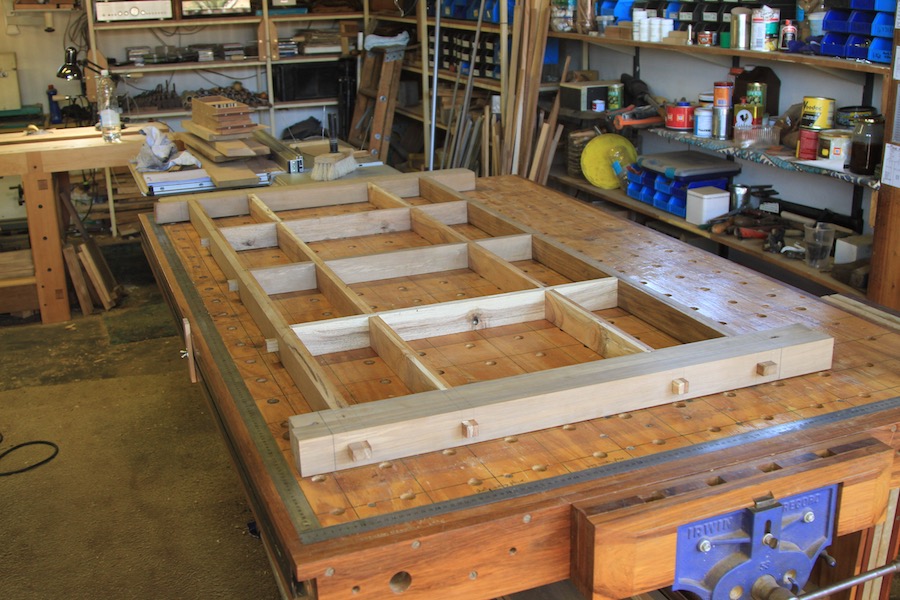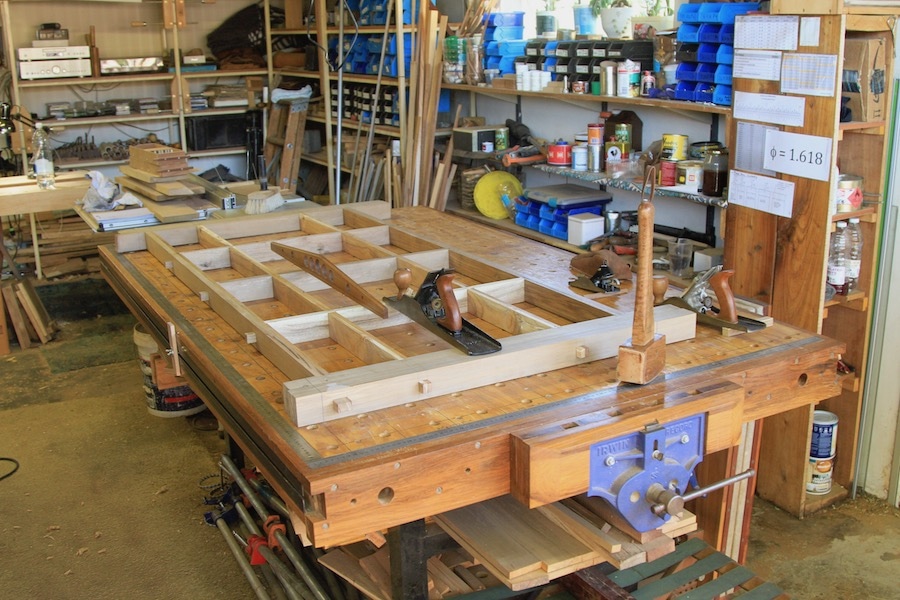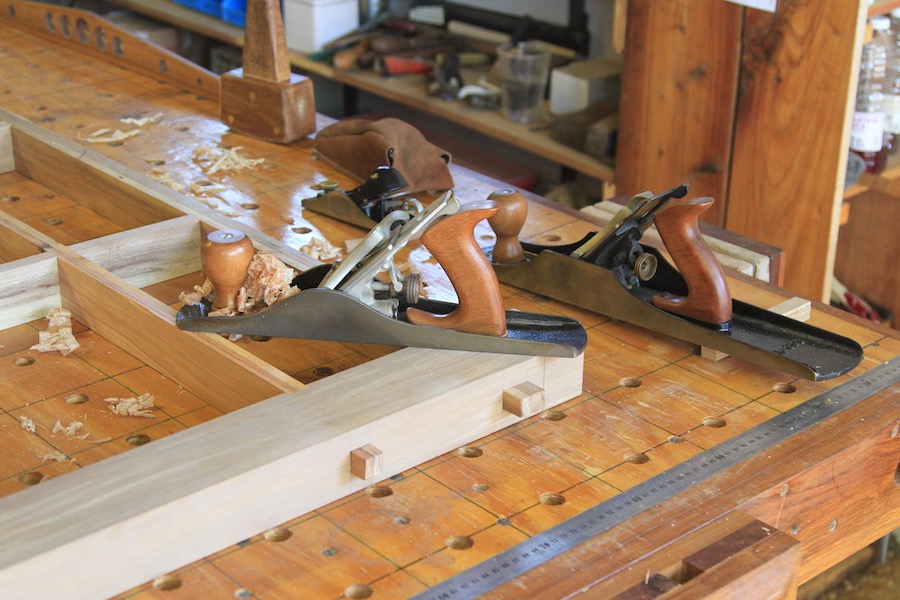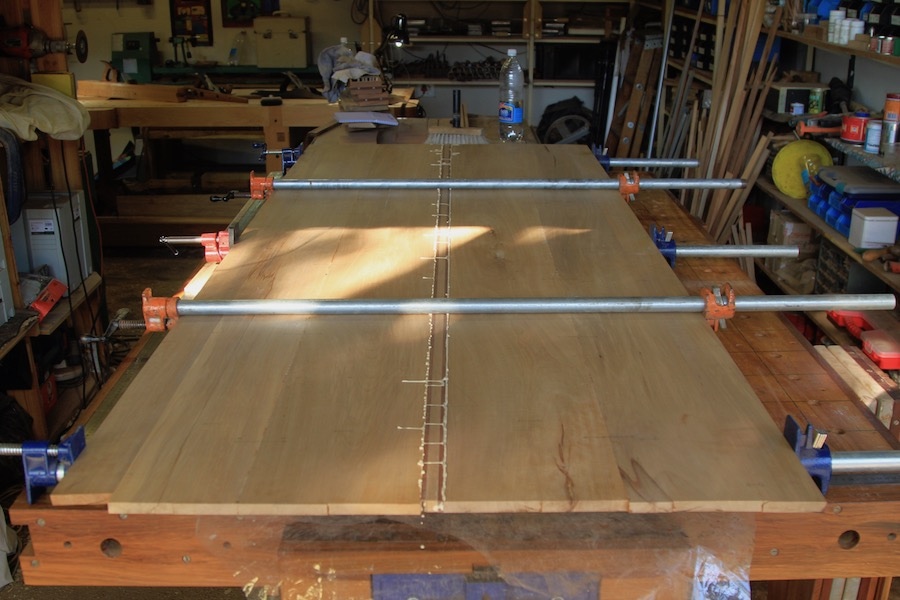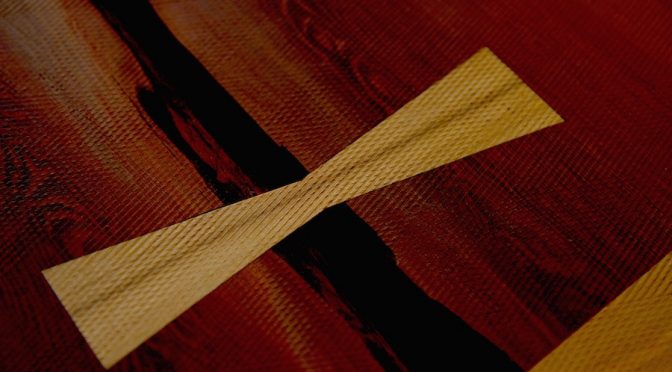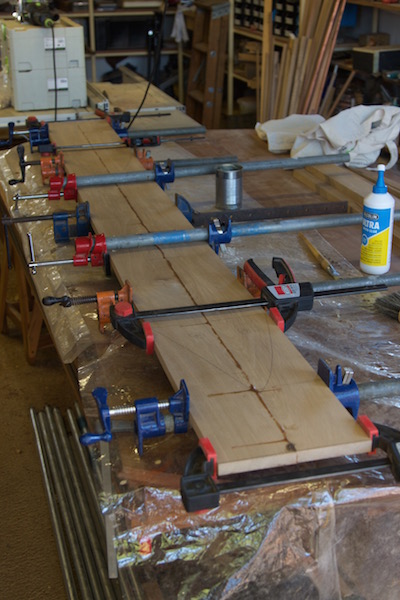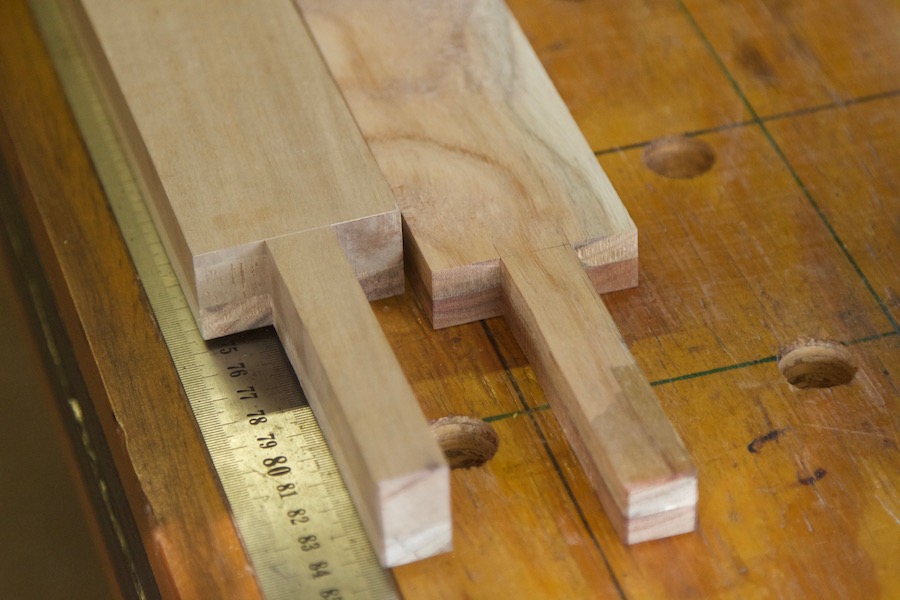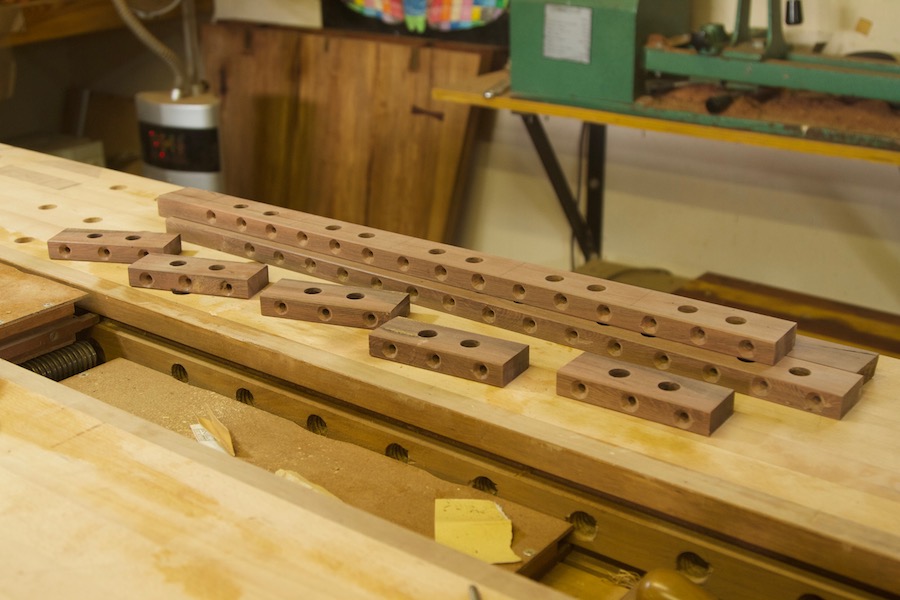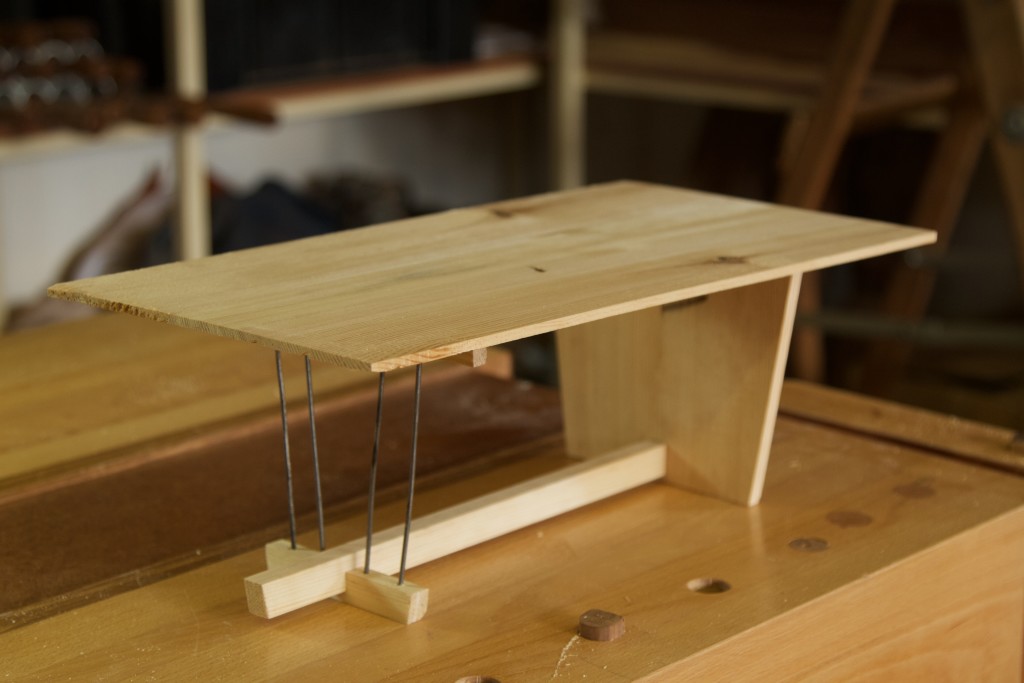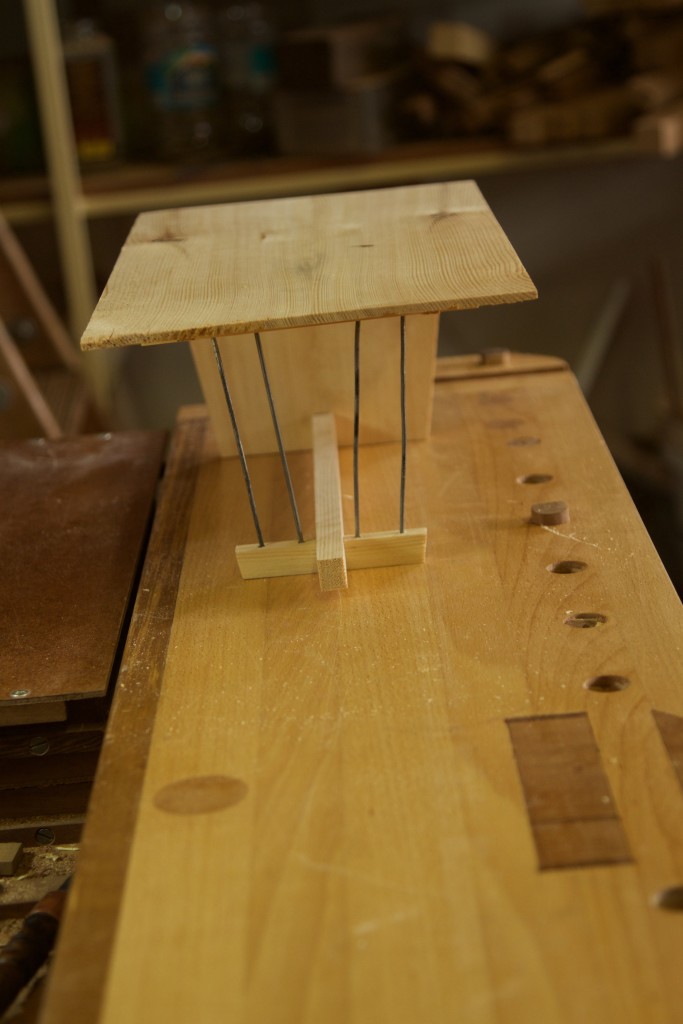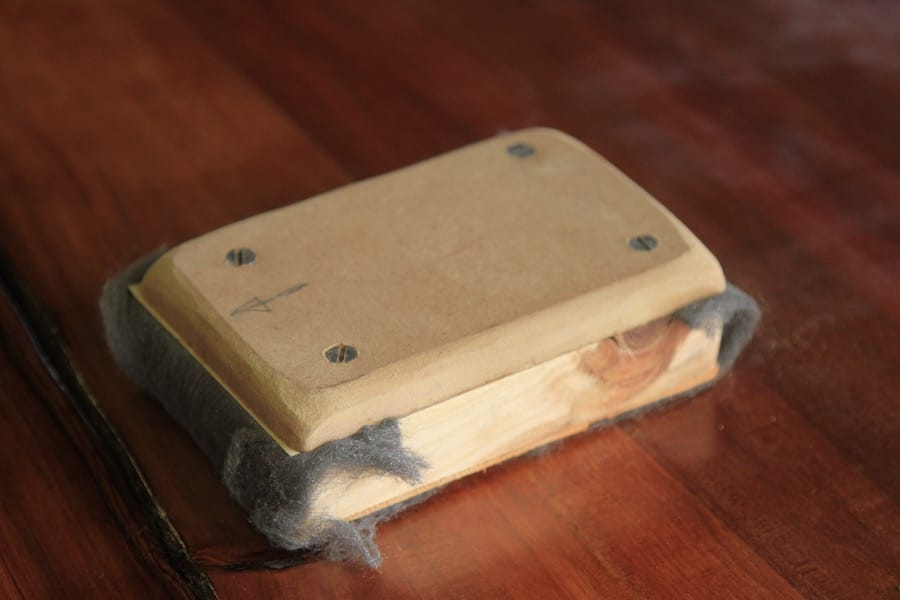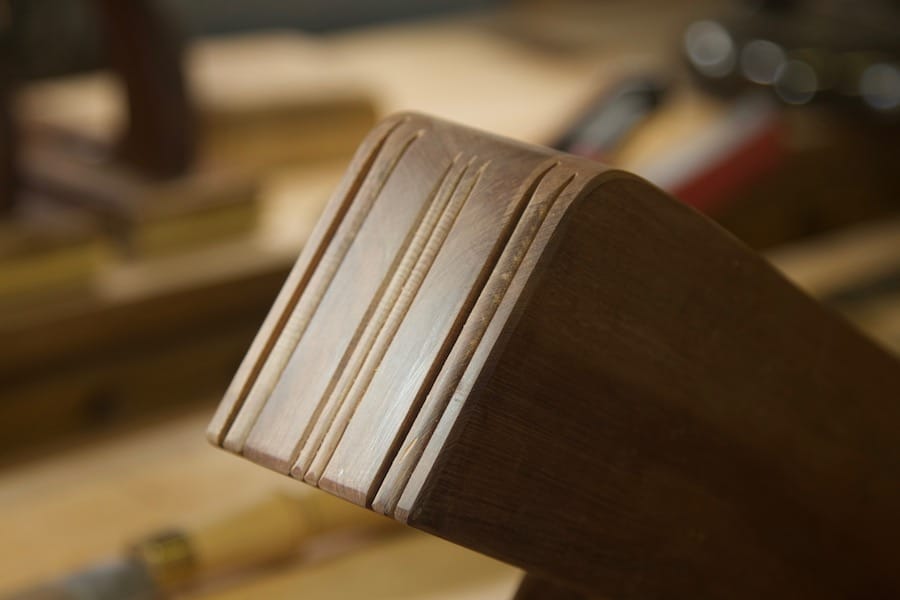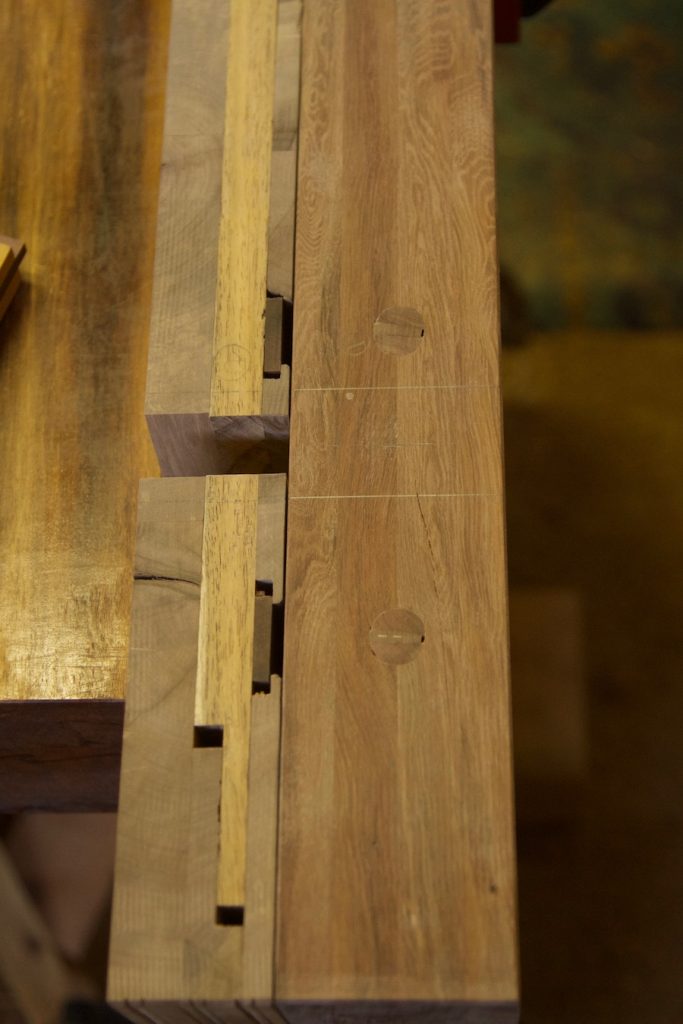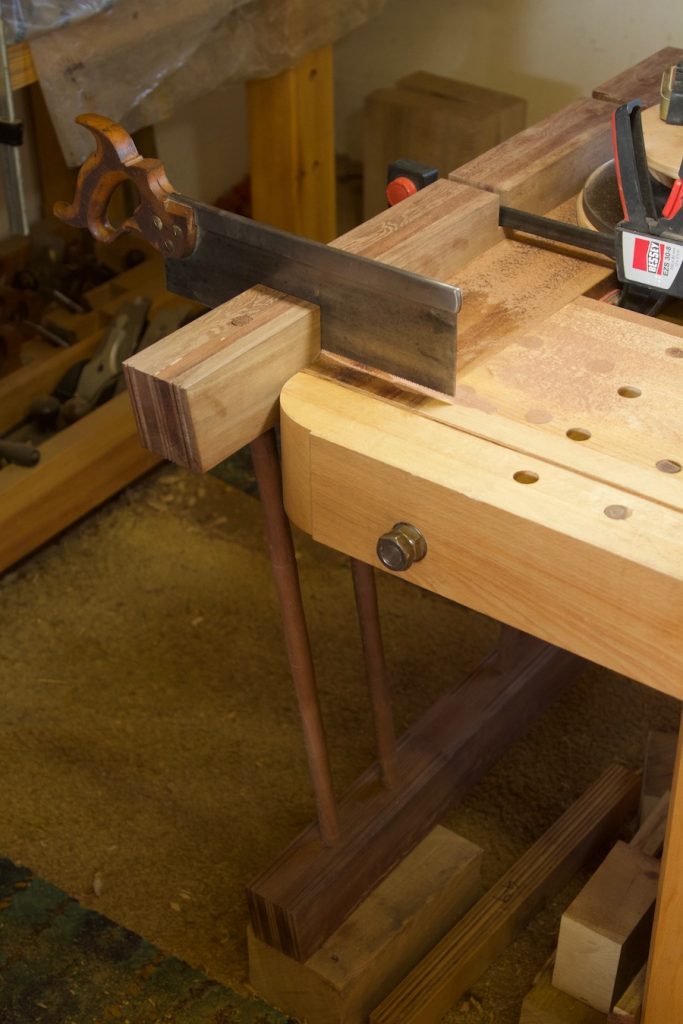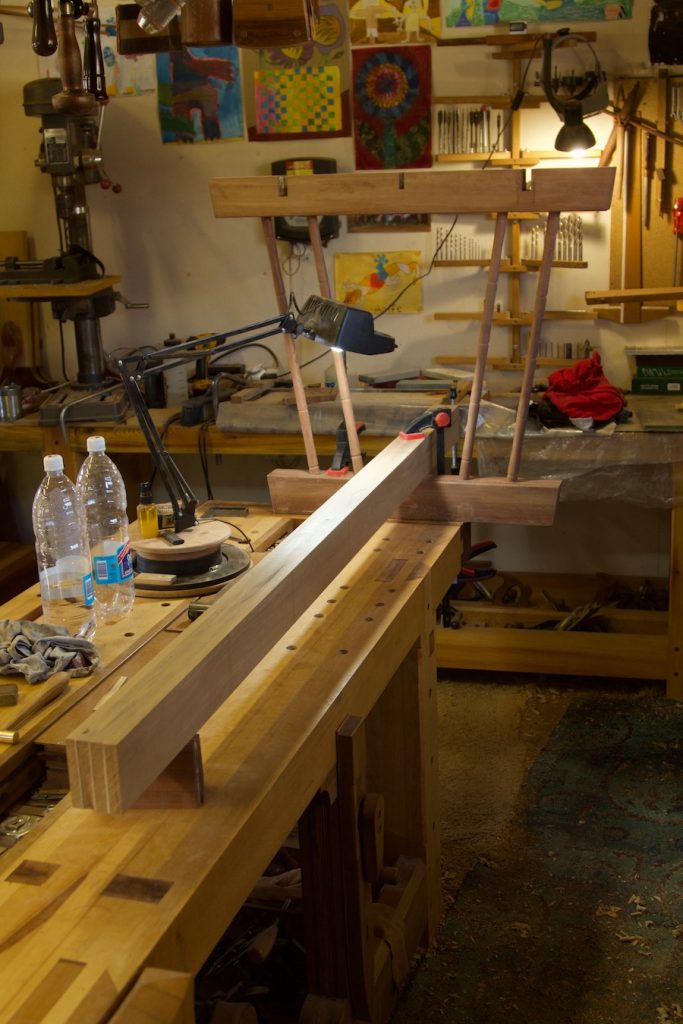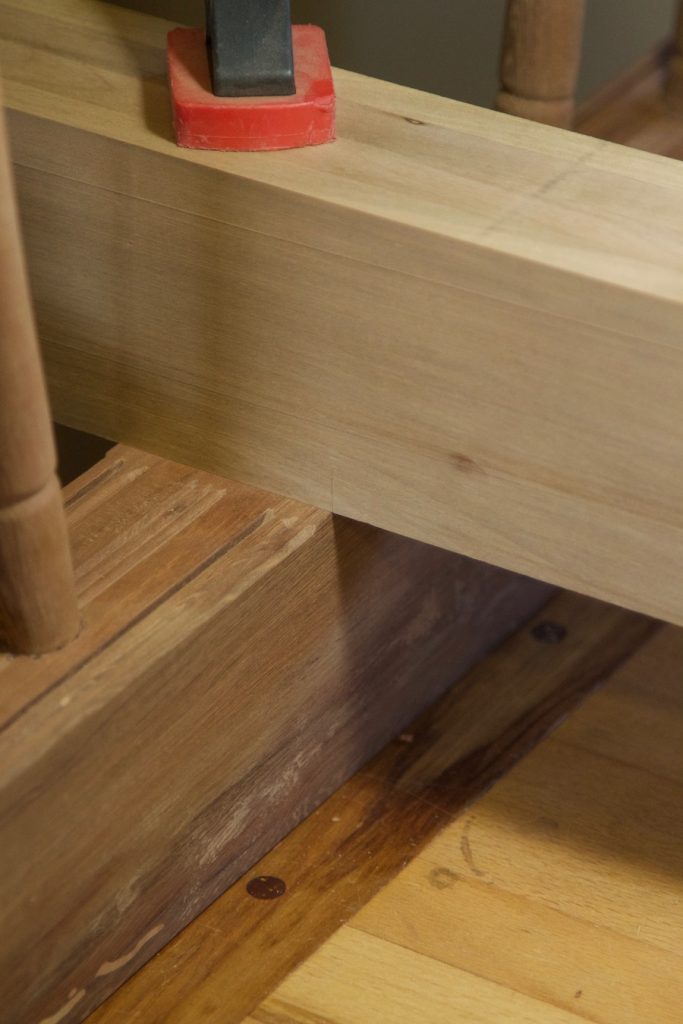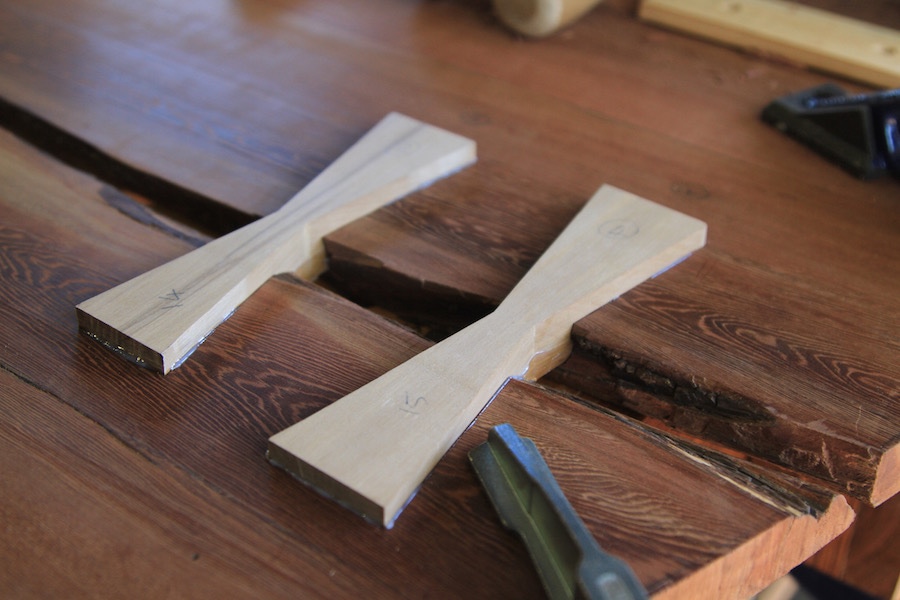6/8/2018
Finally we have chomped our way through the formalities to arrive at the Crème brûlée of the project.
Whoa! I feel good, I knew that I would, now
I feel good, I knew that I would, now
So good, so good, I got you
Anyway let’s get back to the woodworking James Brown. The long board shaped top had the odd defect that was filled it with a mixture of beeswax and Carnauba wax. I heaped some of the wax on top of the said defects and then carefully torched it with a flame.
Once the wax was melted into the defect I removed the excess with a small block of wood used in the same manner as a scraper. I find that there is a sweet spot when it is best to remove the excess. If you wait too long the the wax is too hard and tends to rip bits out that should have stayed intact. If you jump in too early the wax in the defect continues to shrink and you end up with a slightly hollow spot.
For some unknown reason I convinced myself to rely on 21st century technology to drill out the angled holes for the leg tenons. Yes I know, I should have known better.
The first step was to drill a small pilot hole at the correct angle.
That was then followed by an attempt to drill out the rest using this absolute waste of a piece of cheap metal. Half way through my first attempt the so called bit got warped like a soft serve ice cream. On the upside it was just another reminder that I should simply stick to my old hand tools made before the Great War. Since then quality has really left the house, so to speak.
A 14″ brace paired with an appropriately sized Irwin bit made short work of what seemed like an impossible task to humanity’s more recent attempts at tool manufacturing.
Before proceeding to ream out the mortises for the legs, I had to turn a ‘testing stick’, by lack of a better term. It is a very useful aid to test that you are in fact proceeding at the correct angle while reaming. In order to finish the testing stick, I had to fashion the tenon cutter for this particular job. Both these shop made paraphernalia can be seen in the pictures below.
The testing stick in action. You simply stick the stick (mmmm?) in your partially reamed hole and check it with a bevel set to the desired angle. My shop made reamer can be seen resting next to the stick.
Just to contradict myself thoroughly, I have to mention that I might consider the Veritas metal reamer for future mortises of this size. My shop made version struggled with the load created by the large diameter and extreme hardness of the Witpeer. Veritas has a reamer bit that fits on a hand brace, which should make this exercise easier and possibly improve the tolerance of the mortise.
Once the mortises were done, I had to finish shaping the legs. I would say that the biggest surprise of the entire project was how much effort it takes to shape legs like this by hand. It took weeks of hand planing to shape the tapering octagonal design. Having said that, now that it is finished it was all worth while as the end product is absolutely spot on.
The tenons were turned to a smidgen larger than needed.
They were then taken to exact dimensions by feeding it to the tenon cutter.
First leg in it’s mortise. You might be able to discern my makeshift plumb bob testing whether my angle calculations were in fact on the money, in terms of where the leg ends up relative to the edge of the table. Turns out that by some stroke of good fortune, my geometry skills are still with me. That is for the moment anyway.
The tenons were taped off before applying oil followed by shellac.
Speaking of shellac, Mr Miyagi returned for a Karate Kid sequel to finish off the top with said substance.
This time round however I did not waste time by trying to find commercial products to add a protective layer over the secretions of the female Kerria lacca bug. No, I made my own furniture wax while applying the principles of the 1516 Bavarian Reinheitsgebot. In other words, only four ingredients all completely natural. No unknown chemical, to cut corners and ultimately cheapen the quality. The ingredients are as follows: Beeswax (from South Africa), Carnauba wax (from Brazil via Germany), Coconut oil (from Indonesia), Olive oil (from Greece). No more, no less.
In the pictures you can see how my double boiler setup on top of a fairly nasty South African made Primus stove were used to melt the components together. This particular stove is a sorry wannabe compared to the legendary brass models built in Sweden prior to the involvement of pelf peckish corporate halfwits who managed to kill another icon of nobility. Despite that, it is still better than anything you can buy new 40 years later. Sad isn’t it?
My concoction prior to setting. It smells superb …
… and functions even better. After application I left it for a few hours and then buffed off the excess. You will have to wait for the final pictures to see what that looks like.
The legs ended up seating exceptionally well in their respective mortises. I do find it particularly stressful to smash them home with my heavy dead blow mallet, but luckily nothing untoward happened. The mortises were all flared out on the exit side to allow for the introduction of two wedges each. These ensure that the joinery has both mechanical and glue strength.
I also made a special ‘screw-set’ formula using natural waxes and Ballistol mineral oil. It works really well on these old school wood screws in hard wood. It helps to make it easier to set the screw and protects against corrosion for many years to come.
With the table assembled it was time for a photo with these two scalawags.
Marking out the final length of the legs and angle to cut.
We moved it to the kitchen in two piece and reattached the top there.
There you go James Brown.
The table quickly become known as “The Long Board” in the Marx household. I hope you enjoyed this gastronomic woodworking journey. Stay tuned for our next project which will be a Japanese style bed.






